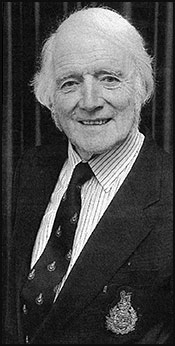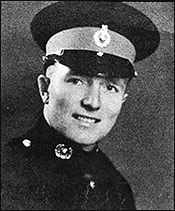LORRYLOADS of servicemen destined for the D-Day landings were given red roses as a reminder of England when they made their way to their landing craft. The touching messages of good luck are now vivid in the memory of Jack Tear, 80, of Cromwell Road, Rushden. This is his own recollection of the events.
 |
|
Jack in 1994
|
"I was a member of the Royal Marine Armoured Support Regiment, a unit specially formed to give close artillery support to the Commandos and other assault troops as they went up the beaches.
We were to go ashore at the same time as them in waterproofed tanks - apparently in previous landings the only heavy guns to help keep the enemy's heads down were from ships two or three miles away.
The tanks and their drivers had been seconded to the Marines from the Royal Armoured Corps and the Marines formed the rest of the tank crews.
We had spent months painting each nut, bolt and welding with special rubber paint to make the tanks waterproof. High extensions had been fitted to the exhausts so that the tanks could operate in water almost to the top of the turrets.
I was in the co-driver position beside the driver and when we entered the tank we drew a hatch to close us in.
To make the hatches waterproof long 'candles' of soft sealing asbestos wax were put round the edges by our ammunition squad and this worked well during underwater trials.
On June 4, 1944, the Sunday before D-Day, we left camp on the A18 near Havant, Hampshire, in open-topped trucks to go aboard our landing craft at Stokes Bay. The roads were crowded with vehicles crawling along bumper to bumper.
Every time we stopped local people who guessed what was happening, greeted us with 'Good Luck, God BJess' and gave us each a rose saying: 'Here's a bit of England to take with you.' It was very emotive.
The tanks were already chained to the deck of the landing craft when we went aboard, one being raised on Bailey bridging so it could fire above the other.
There were only two tanks on the tiny, flat-bottomed craft. We were told they were made by a firm called Kaiser in America, being shipped over in three parts and joined together in Great Britain.
Discomfort and apprehension made sleep impossible and about 5am on June 5 we set off for Normandy. What a journey it was too. There was a heavy swell and our flat-bottomed craft went rhythmically up and down, up and down, but occasionally would catch the top of a wave and shudder as though it might break in two.
There were about 24 persons aboard, five in each tank crew, six ammunition squad Marines and about eight seamen, and most of them were seasick at least once. All through the day and night we endured this queasiness and then at daybreak on Tuesday, June 6, we saw and marvelled at the magnitude of the invasion forces.
As far as we could see each side and behind us were craft of every size imaginable, while overhead bombers, fighters and transport planes towing two or three gliders each were all moving in the same direction.
 |
|
In service
|
About two miles from the beach we took posts in the tanks and started firing our 85 millimetre guns, applying range and direction adjustments as instructed over the radio.
At about 8.30am our craft struck the beach, our tank was unchained and we entered the water. As soon as we did this water poured in on the driver and myself. In the excitement our ammunition squad had forgotten to apply the sealing wax to the hatches.
The intercom was put out of action, so we removed our headphones and all instructions had to be shouted above the roar of the engine. All the air to feed this great engine was coming through the open turret and it was almost sucking our eardrums out. Also each time the gun was fired it felt as though someone was clapping both hands over our ears at the same time.
We moved forward till the water stopped coming in. Someone in the turret shouted 'Our craft's been hit - they're wading ashore.'
One of our ammunition squad came by and shouted: 'Eric's been killed; Smithy, Davies and some sailors have been wounded.' I felt numb, we had left the craft about 10 minutes earlier. Eric Youngman was my special friend and was just 23 years old.
The other tank was still on the craft, marines and sailors had been sheltering behind it when a shell hit the superstructure behind it and shrapnel splattered down on them.
We were now firing at gun emplacements and other selective targets. Occasionally, we could hear shrapnel pepper the tank as shells exploded nearby.
After the gun emplacements were taken by the assault troops we moved out of the water, each tank was towing two ammunition holders called porpoises.
These were like river punts with covers on. Medical Corps personnel who were giving first aid to casualties placed several of them on our porpoises and we carried them higher up the beach.
Tanks with revolving flails in front were moving forwards and backwards, and occasionally would explode a personnel mine hidden in the sand. Other tanks were laying wooden tracks from great rolls so that wheeled vehicles could move up the beach without sticking in the sand.
Other tanks in our unit came ashore, we got out of the tanks to stretch our legs and replace the used shells from the porpoises.
We also learned very quickly to throw ourselves to the ground every time an enemy shell screamed close to us, and never seemed to get bruised by doing so.
We examined our tank. Pieces of red hot shrapnel had welded themselves to it. Great chunks of rubber had been gouged out of the track bogie wheels, and the storage compartments above the tracks were pitted like pepper pots.
I looked around at the many casualties still being attended to on the beach. I thought of Eric and all the others who had died within the last few hours and thanked God that I was not one of them."
|